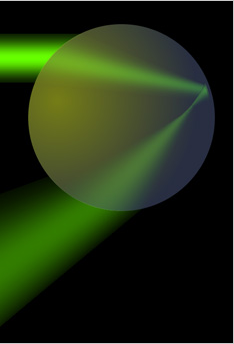Fogbow formation
Fogbow Formation: The Mystical Beauty of Atmospheric Optics
Have you ever witnessed a mesmerizing circle of light in the foggy atmosphere? If so, you may have encountered a fascinating phenomenon known as a fogbow. Similar to rainbows, fogbows are formed when light interacts with water droplets in the air. However, there are significant differences between these two optical marvels that make fogbows a unique and captivating sight to behold.
Unlike rainbows, which are created by raindrops that follow well-defined paths of light, fogbows are formed by much smaller cloud and fog droplets that diffract light extensively. When sunlight enters these tiny droplets, a small portion of the light is internally reflected once and emerges to form a large circle opposite the sun. This process gives rise to the ethereal beauty of a fogbow.
The Play of Light in Fogbows
The emergence of light in fogbows is a complex interplay of refraction, diffraction, and interference. As light enters the droplets, it undergoes refraction, causing it to change direction. A small proportion of the light is then internally reflected within the droplet before finally leaving from the same side it entered. This refracted and internally reflected light forms the primary fogbow, which appears as a broad circle with a radius of 30-45° centered on the antisolar point – the point directly opposite the sun.
Unlike rainbows, which exhibit vibrant and distinct colors, fogbows appear almost white, with faint hints of red on the outside and blues on the inside. The washed-out colors of fogbows result from the broad nature of the bow in each color, causing them to overlap and blend together. The overlapping colors create a soft and ethereal appearance that adds to the mystique of fogbows.
Supernumerary Bows: A Delicate Dance of Light
Within the main arc of a fogbow, you may occasionally witness a series of faint, closely spaced bows. These delicate bows are known as supernumerary bows and are produced by the constructive and destructive interference of overlapping wave crests along the main light path. The interplay of these wave crests creates a delicate dance of light, resulting in the formation of these additional bows within the fogbow.
The Direction of Light in Fogbows
Unlike rainbows, which have well-defined ray paths due to the larger size of raindrops, fogbows exhibit diffraction effects dominated by the smaller droplets in clouds and fog. Consequently, light in fogbows is mostly deviated approximately 135 to 150° from its incident direction. This deviation is similar to the angle of minimum deviation in geometric optics, which is approximately 138° for a rainbow with a radius of 42°. The deflection of light in fogbows contributes to the unique appearance and shape of these atmospheric wonders.
Capturing the Beauty of Fogbows
Photographing fogbows can be a rewarding challenge due to their subtle colors and diffuse nature. To capture the beauty of a fogbow, it is best to use a wide-angle lens to encompass its entire radius. Additionally, adjusting the exposure settings to bring out the faint colors and ensuring a steady hand or tripod for stability can help capture the enchanting essence of this atmospheric phenomenon.
Exploring the Wonders of Atmospheric Optics
Fogbows are just one example of the captivating optical phenomena that occur in our atmosphere. From rainbows and halos to sundogs and iridescence, the world of atmospheric optics is filled with awe-inspiring wonders waiting to be discovered. So, the next time you find yourself surrounded by foggy conditions, keep your eyes open for the mystical beauty of a fogbow – a testament to the intricate dance between light and water droplets in our atmosphere.

Fogbow light directions. Light is refracted on entry. A small proportion is internally reflected and then leaves from the side it entered. Diffraction effects dominate in small droplets and there are no well defined ray paths. Light is mostly directed 135-150° from its original path to form a broad circle of 30-45° radius around the antisolar point.
Fogbows form in the same way as rainbows. A small fraction of the light entering droplets is internally reflected once and emerges to form a large circle opposite the sun.
But... ...beyond that there are major differences. Rainbows are formed by raindrops which are so large that rays passing through them follow well defined 'geometrical optics' paths. Fogbows are formed by much smaller cloud and fog droplets which diffract light extensively.
The emergent light is mostly deviated 135 to 150° from its incident direction to produce the main fogbow of 30 - 45° radius centered on the antisolar point. The deviation corresponds roughly to the geometric optics angle of minimum deviation of ~138° for the 42° radius rainbow.
Fogbows are almost white with faint reds on the outside and blues inside. The colours are so washed out because the bow in each colour is very broad and the colours overlap.
Widely spaced supernumerary bows inside the main arc are produced by the constructive and destructive interference of overlapping wave crests along the main light path...
Note: this article has been automatically converted from the old site and may not appear as intended. You can find the original article here.
Reference Atmospheric Optics
If you use any of the definitions, information, or data presented on Atmospheric Optics, please copy the link or reference below to properly credit us as the reference source. Thank you!
-
<a href="https://atoptics.co.uk/blog/fogbow-formation/">Fogbow formation</a>
-
"Fogbow formation". Atmospheric Optics. Accessed on April 19, 2024. https://atoptics.co.uk/blog/fogbow-formation/.
-
"Fogbow formation". Atmospheric Optics, https://atoptics.co.uk/blog/fogbow-formation/. Accessed 19 April, 2024
-
Fogbow formation. Atmospheric Optics. Retrieved from https://atoptics.co.uk/blog/fogbow-formation/.